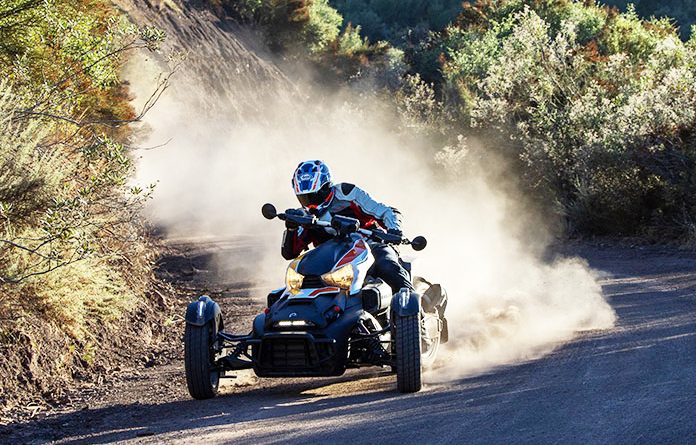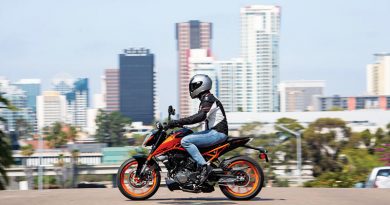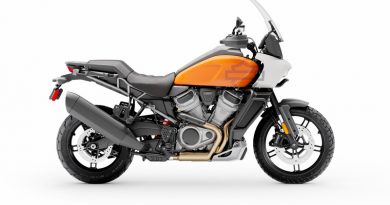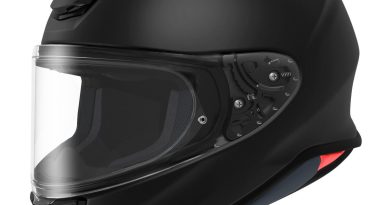2023 Can-Am Ryker Rally Review | Road Test
Having recently celebrated my 50th birthday, I’ve already slipped into the old guy pastime of nostalgia, feeling wistful about days gone by. Seems like just yesterday that I was the know-nothing FNG on Rider’s staff, having just crawled out of the post-Hurricane Katrina, post-divorce wilderness, desperate to turn my life around. Within my first two months, still just a clueless oaf who won the dream-job lottery, I had not only reveled in the glory of being featured on the cover of the magazine but also suffered the humiliation of crashing two test bikes.
Perhaps to get me out of his hair while he decided if I was worth the trouble, former EIC Mark Tuttle handed me the key to a 2008 Can-Am Spyder and told me to get lost. Rather than being in the doghouse, my leash was unclipped. I packed my gear, hit the road, and returned one week and 2,600 miles later.
I’d like to think I’ve grown not only older but a little wiser since then. While that last part is debatable, the Spyder has certainly come a long way since my first ride. What started out as a single model introduced in 2007 – the Spyder RS roadster – has evolved into three model families: the playful Can-Am Ryker, the cruiser-like Spyder F3, and the touring-ready Spyder RT, with a total of 10 models between them. All share what parent company BRP calls “Y-architecture,” with two wheels in front and one in the back.
As three-wheeled vehicles (3WVs), Can-Am Rykers and Spyders don’t lean like two-wheelers do. Many motorcyclists dismiss them outright because of that, but their inherent stability is what the buyers of over 282,000 Can-Am 3WVs sold over the past 16 years love most about them.
I like anything on which I can go fast and have fun. Two wheels, three wheels, no wheels – doesn’t matter. Over Labor Day weekend, my brother-in-law and I bombed around on a pair of Sea-Doo watercraft (also made by BRP) at speeds up to 55 mph on the Intercoastal Waterway in Jacksonville, Florida, roosting spray and jumping waves with huge grins on our sunburned faces. So it felt perfectly natural to come home to California and hoon around on backroads and dirt byways on a Ryker Rally.
Can-Am Ryker Rally Redux
Introduced in 2019, the Can-Am Ryker is the youngest member of the company’s 3WV tribe, and it was designed to attract new riders. All Spyder F3 and Spyder RT models are powered by a 115-hp, 1,330cc Rotax ACE (Advanced Combustion Efficiency) inline-Triple, and their model-year 2023 prices range from $18,499 to $30,999. The Ryker provides a more accessible entry point in terms of power and price. The base model is available with a 50-hp 600cc Rotax ACE parallel-Twin for $8,999 or an 82-hp 900cc Rotax ACE inline-Triple for $10,699.
Related: 2024 Can-Am Spyder F3 and RT Review | First Look
Like their Spyder brethren, Rykers are equipped with a Bosch-engineered Vehicle Stability System, which includes stability control, traction control, hill-hold control, and ABS. Spyders have Dynamic Power Steering, but Rykers do not, which gives them a more direct and natural handling feel. Rykers also have a driveshaft (Spyders are belt-driven), fully automatic CVT transmissions with reverse, and the UFit system, enabling handlebar and footpeg position to be adjusted without tools. Accessory body panels available in a wide range of colors allow Ryker owners to personalize their machines.
The Can-Am Ryker 900 has a standard ride mode, as well as Eco, which softens throttle response for better fuel economy, and Sport, which has more aggressive throttle response, turns off traction control at the rear wheel, and reduces VSS intervention to allow greater slip angles (slides).
Can-Am also offers two up-spec 900cc models: the Ryker Sport ($11,899) and the Ryker Rally ($13,899), both of which add cruise control and a MAX mount behind the rider’s seat for an accessory top trunk or passenger seat. The Sport adds a sport comfort seat, a full rear fender, and sport-style trim and finishes.
The Rally, which is designed to be ridden off-road, has reinforced wheels with rally tires, front grille protection, a rally handlebar with handguards, large cleated footpegs, an aluminum skid plate, a pre-filter for the air intake, mud flaps, auxiliary LED lights, and an Akrapovič exhaust. Instead of Sport mode, it has a Rally mode calibrated for low-traction surfaces.
Our Ryker Rally test machine was clad in all-black bodywork with a white handlebar and white wheels. (For 2024, Rally models will come with Hyper Silver wheels.) Since most of the Ryker is covered in matte-black plastic, we brightened it up by replacing the standard Intense Black front and side accent panels with the racier Heritage White IV set ($399.99), which has yellow and red stripes on a white background. The body panel kit, however, doesn’t extend to the accessory Mono Seat Cowl ($114.99) fitted on our test unit’s MAX mount, which would have rounded out the go-fast aesthetic.
Hoon Dog
With its twist-and-go CVT, peppy engine, Rally mode, wide handlebar, low seat, and feet-forward riding position, the 2023 Can-Am Ryker Rally is what Dr. Frankenstein would get if he stitched together a scooter, a cruiser, a go-kart, and an ATV. That may sound a little weird, but the result is a riding experience like no other.
GEAR UP
Helmet: Arai XD4
Jacket: Scorpion Yosemite
Gloves: Scorpion SGS MK II
Pants: Scorpion Covert Pro Jeans
Boots: TCX Infinity 3 Gore-Tex
At a stop light, take your foot off the brake pedal and pin the throttle, and the Ryker will light up the rear tire for a moment before the electro-nanny, er, VSS kicks in and the rubber hooks up. According to the owner’s manual, Rally mode is only intended for unpaved roads, but in the interest of thorough evaluation, I tested it on pavement and had a fair amount of fun. But with an 82-hp engine powering a 668-lb (dry) machine, we’re not talking Dodge Hellcat-like smoky burnouts or drifts.
Get the Rally on dirt or gravel, however, and it parties like it’s 1999. A quick flick of the wrist gets the rear wheel spinning, and if you keep giving the Ryker throttle, it will slide around until your arm gets tired. The tricky bit is correct steering input. Kick the tail out and steer to match the rear, and you’re treated to a sweet crossed-up powerslide. But kick the tail out with the handlebar turned in the other direction, and the front end will push sideways. Or you can go totally gonzo and pin the throttle, crank the bar, and whip the Ryker around in a donut while kicking up a giant cloud of dust.
Since I’m not an expert off-road rider or rally car driver, it took me a while to get the hang of things. But, like sex and pizza, even when it was bad it was still pretty good, and I can’t remember the last time I had so much fun raising hell on wheels.
The Ryker was very forgiving of my mistakes, and even a few close calls were handled with minimal drama thanks to the stability of the two front wheels and the VSS, even with intervention reduced. Had I tried half the antics I did on the Ryker on an adventure bike, I would have been on my butt many times over.
Related: Can-Am Motorcycle Videos Celebrate Brand’s 50-year History and Its Electric Future
Street Wise
As with adventure bikes, most Rykers will spend the majority of their time on pavement. Of the hundreds of miles I logged on the Ryker Rally, only a few dozen were off-road. On the street, the Ryker is engaging and responsive. Between the continuously variable transmission and shaft drive, there’s a bit of driveline lash when first rolling on the throttle from a stop and at low speeds, but I quickly got used to it.
Response from the throttle-by-wire is direct with no delays or snatchiness, and power builds steadily with no apparent dips. The ACE inline-Triple, however, lacks character. Smoothness is a virtue on a touring machine such as a Spyder RT, but for a vehicle Can-Am says is “designed for fun,” I wanted more liveliness, more audible rumble. Even though the Rally has a racy-looking carbon-tipped Akrapovič exhaust, it emits only the mellowest of burbles.
Riding a Ryker at a sporting pace can be quite a workout. What a 3WV gives in terms of stability, it takes away in terms of graceful agility. Whereas a motorcycle rolls into and out of turns, the Ryker must fight against body roll, with weight pushing against the outside front wheel and lightening the inside wheel. As a motorcycle leans into a corner, centrifugal force pushes the rider down into the seat. Because the Ryker doesn’t lean into turns, the rider must brace themselves against the outside peg and actively lean their body to the inside. Keeping the Ryker on a steady line through a corner while keeping its 5-foot width between the mustard and the mayo also requires muscle at the handlebar. With no hand brake lever, all braking force goes through the foot pedal, which engages the calipers on all three wheels simultaneously. It took a while to adapt, but there’s plenty of stopping power at the ready.
A low center of gravity, double A-arms with an anti-roll bar, and adjustable KYB high-pressure gas shocks keep the Ryker stable, and the VSS applies braking to the outside wheel as needed to maintain control, but if you go into a corner too hot, it will understeer and push sideways. The front suspension does a good job of isolating and damping hard hits, and overall, the chassis provides a smooth, steady ride. With three separate wheel tracks, though, it can be difficult to dodge potholes or debris in the road. The situation was even more challenging off-road when trying to avoid big, sharp rocks. With only 4.8 inches of ground clearance, care must be taken to avoid high-centering the Ryker on rises, ridges, and ruts.
Dial it back, however, and the Ryker settles into comfortable docility. Thanks to its 26.6-inch seat height and adjustable ergonomics, it fits a wide range of riders. The wide, soft seat is comfortable but lacks the support needed for a full day in the saddle. (Can-Am’s accessories list includes comfort seats for the rider and passenger, along with windscreens, luggage, audio, heated grips, and much more.) The steady thrum of the engine becomes an asset on the freeway, with the three automobile-sized contact patches and two front wheels keeping the Ryker steady in crosswinds.
Amenities on the Ryker Rally include cruise control, dual USB ports, LED lights on the front fenders, and a 7-liter lockable glovebox that will hold an extra pair of gloves and a couple of water bottles but not much else. When the ignition is turned off, the Ryker beeps until you engage the parking brake (at a stop the CVT is always in neutral). Instrumentation consists of a small orange-backlit LCD display that, by today’s standards, looks outdated. Information is limited to speedometer, tachometer, odometer, A/B tripmeters, clock, ride mode, fuel level, and distance to empty. Like other Can-Am 3WVs we’ve tested, a heavy throttle hand combined with a low power-to-weight ratio on the Ryker Rally returned poor fuel mileage – just 30.3 mpg, or about 160 miles per tank.
The Kids Are Alright
When I tested the original Spyder in 2008, it was a novelty, something futuristic and intriguing to everyone from teenagers and their soccer moms to members of the Peacemakers MC when I rode it to their bikini bike wash fundraiser in Utah. A decade and a half later, the Spyder is all grown up, having become an established, tax-paying member of the powersports community. The Can-Am Ryker, on the other hand, is young and brash, more interested in fun than respectability. And the Rally is the most mischievous one of the bunch.
2023 Can-Am Ryker Rally Specs
Base Price: $13,899 ($14,599 in 2024)
Price as Tested: $14,413 (Exclusive Panel Kit, Mono Seat Cowl)
Warranty: 1 yr., unltd. miles w/ roadside assistance
Website: Can-Am.BRP.com
ENGINE
Type: Liquid-cooled, transverse inline-Triple, DOHC w/ 4 valves per cyl.
Displacement: 899.3cc
Bore x Stroke: 74.0 x 69.7mm
Compression Ratio: 11:1
Valve Insp. Interval: N/A (self-adjusting)
Fuel Delivery: EFI w/ 46mm throttle body & throttle-by-wire
Lubrication System: Dry sump, 3.0 qt. cap.
Transmission: Fully automatic CVT w/ reverse
Final Drive: Shaft
CHASSIS
Frame: Tubular-steel space frame w/ cast aluminum single-sided swingarm
Wheelbase: 67.3 in.
Rake/Trail: N/A
Seat Height: 26.6 in.
Suspension, Front: Double A-arm, dual high-pressure gas remote-reservoir shocks w/ 4-postion compression & preload adj., 7.3 in. travel
Rear: Single, multi-link high-pressure gas remote-reservoir shock w/ 4-position compression & preload adj., 7.1 in. travel
Brakes, Front: Dual 270mm discs w/ 2-piston calipers & ABS
Rear: Single 220mm w/ 1-piston caliper & ABS
Wheels, Front: Cast, 16 x 4.5 in.
Rear: Cast, 15 x 6.5 in.
Tires, Front: 145/60-R16
Rear: 205/55-R15
Dry Weight: 668 lb
Load Capacity: 412 lb
GVWR: 1,080 lb
PERFORMANCE
Horsepower: 82 @ 8,000 rpm (factory claim)
Torque: 58.3 lb-ft @ 6,500 rpm (factory claim)
Fuel Capacity: 5.3 gal.
Fuel Consumption: 30.3 mpg
Estimated Range: 160 miles
See all of Rider‘s Can-Am coverage here.
The post 2023 Can-Am Ryker Rally Review | Road Test appeared first on Rider Magazine.




